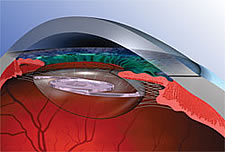A cloudy lens interferes with light passing through to the retina, the light-sensing layer of cells at the back of the eye. Having a cataract can be compared to looking at the world through a foggy window. Phacoemulsification is a surgical method used to remove a cataract, which is a clouding of the eye’s naturally clear lens.
 In phacoemulsification, an ultrasonic oscillating probe is inserted into the eye through a small incision. The probe breaks up the center of the cataractous lens. The fragments of the cataract are then suctioned from the eye. The small incision used does not require sutures to close, since the cataract is removed in tiny pieces. The back-portion of the supportive lens capsule or “bag” is left behind and a foldable intraocular lens (IOL) is implanted permanently inside the “bag” to help focus light onto the retina. Vision returns quickly and one can resume normal tasks, within a week for most activities.
In phacoemulsification, an ultrasonic oscillating probe is inserted into the eye through a small incision. The probe breaks up the center of the cataractous lens. The fragments of the cataract are then suctioned from the eye. The small incision used does not require sutures to close, since the cataract is removed in tiny pieces. The back-portion of the supportive lens capsule or “bag” is left behind and a foldable intraocular lens (IOL) is implanted permanently inside the “bag” to help focus light onto the retina. Vision returns quickly and one can resume normal tasks, within a week for most activities.
 Cataract surgery is a very successful operation. One and a half million people have this procedure every year in North America, and 95% have a successful result. As with any surgical procedure, complications can occur during or after surgery, and some are severe enough to limit vision. In the vast majority of cases, vision and quality of life are improved.
Cataract surgery is a very successful operation. One and a half million people have this procedure every year in North America, and 95% have a successful result. As with any surgical procedure, complications can occur during or after surgery, and some are severe enough to limit vision. In the vast majority of cases, vision and quality of life are improved.

